

Configuring IP Access Lists. Introduction This document describes how IP access control lists (ACLs) can filter network traffic.

It also contains brief descriptions of the IP ACL types, feature availability, and an example of use in a network. Access the Software Advisor (registered customers only) tool in order to determine the support of some of the more advanced Cisco IOS® IP ACL features. contains assigned numbers of well-known ports. RFC 1918 contains address allocation for private Internets, IP addresses which should not normally be seen on the Internet. IOS VPN(Router): Add a New L2L Tunnel or Remote Access to an Existing L2L VPN. Introduction This document provides the steps required to add a new L2L VPN tunnel or a remote access VPN to a L2L VPN configuration that already exists in an IOS router.

Prerequisites Requirements Ensure that you correctly configure the L2L IPSec VPN tunnel that is currently operational before you attempt this configuration. Components Used The information in this document is based on these software and hardware versions: Two IOS routers that run software versions 12.4 and 12.2 One Cisco Adaptive Security Appliance (ASA) that runs software version 8.0 The information in this document was created from the devices in a specific lab environment.
Conventions. Configuring an IPsec Router Dynamic LAN-to-LAN Peer and VPN Clients. Introduction This configuration shows a LAN-to-LAN configuration between two routers in a hub-spoke environment.
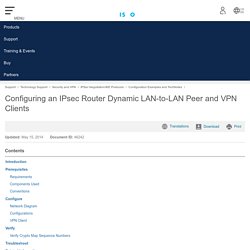
Cisco VPN Clients also connect to the hub and use Extended Authentication (Xauth). The spoke router in this scenario obtains its IP address dynamically via DHCP. The use of Dynamic Host Configuration Protocol (DHCP) is common in situations where the spoke is connected to the Internet via a DSL or cable modem. This is because the ISP often provisions IP addresses dynamically using DHCP on these low-cost connections. Without further configuration, the use of a wild-card pre-shared key on the hub router is not possible in this situation. The introduction of ISAKMP profiles in Cisco IOS® Software Release 12.2(15)T makes this configuration possible since you can match on other properties of the connection (VPN Client group, peer IP address, fully qualified domain name [FQDN], and so forth) rather than just the peer IP address. Solved: ACL with schedule.
Conditional Port Forwarding (NAT) on Cisco IOS. The company I work for provides (among other things) VoIP solutions to small businesses.
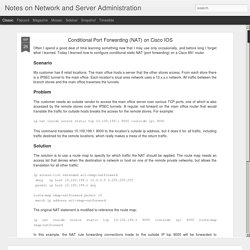
For many of these customers we provide network administration in addition to Internet telephony, and I have the good fortune to design and implement the network architecture and manage the routers and switches. Increasingly I've been drawn into direct support of the VoIP phones. We use Polycom 550s at our customer sites with Asterisk (Elastix) in our data center. One problem I've been tasked with solving is the slow recovery of the phones after a network interruption such as a router reboot or a fail over from customer Internet connection to another.
That is to say, if the path by which the phones established their connection to the server is broken, the server cannot to the phones even after the path is restored, not until the phones reconnect themselves. Here's the scenario: Our customer has two Internet connections. Limiting access to forwarded ports in Cisco iOS.
The following should probably be obvious, but I had a surprisingly hard time figuring out the official Cisco documentation.

The scenario is as follows: a gateway Cisco router provides internet access via NAT for, say, your office. It therefore has an external interface (called Dialer0, for example) which is connected to the uplink (this could e.g. be a DSL line), and an internal ethernet interface connected to the internal office network: ^ | | Dialer0: 87.224.25.11 | +-------+-------+ | | | Cisco | | | +-------+-------+ | | GigabitEthernet0/0: 192.168.1.1 | v If you would like to make machines that are part of the internal 192.168.1 network accessible from the outside, then this can be easily achieved by forwarding ports on the Cisco: cisco# conf t cisco(config)# ip nat inside source static tcp 192.168.1.55 80 interface Dialer0 8080 Now, accessing your uplink DSL IP 87.224.25.11 at port 8080 will connect you with your internal server 192.168.1.55 at port 80.
NAT Order of Operation. Introduction This document illustrates that the order in which transactions are processed using Network Address Translation (NAT) is based on whether a packet goes from the inside network to the outside network, or from the outside network to the inside network.
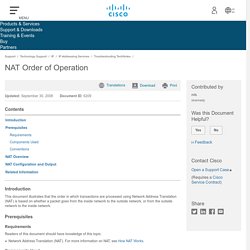
Prerequisites. Verifying and Troubleshooting DHCP Configuration > CCNP SWITCH Portable Command Guide: Implementing Inter-VLAN Routing. Cisco 800 Series Integrated Services Routers Software Configuration Guide - Basic Router Configuration [Cisco 800 Series Routers] How To Configure DNS Server On A Cisco Router. The DNS protocol is used to resolve FQDN (Fully Qualified Domain Names) to IP addresses around the world.

This allows us to successfully find and connect to Internet websites and services no matter where they are. Its usefulness, however, doesn't stop there: local company and private networks also rely on DNS to operate efficiently and correctly. In many cases, where a local DNS server is not available, we are forced to either use our ISP's DNS servers or some public DNS server, however, this can sometimes prove troublesome. Today, small low-end routers have the ability to integrate DNS functionality, making life easier, but so do Cisco routers - they simply have to be setup and you're done.
Policy Group Assignment for AnyConnect Clients That Use LDAP on Cisco IOS Headends Configuration Example. EtherSwitch Network Module (ESW) Configuration Example. VLAN ON ROUTER - 14588. A vlan configuration on a router is slightly different than on a switch.
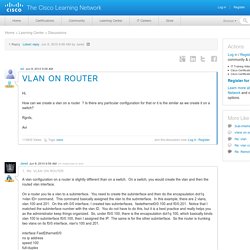
On a switch, you would create the vlan and then the routed vlan interface. How do I secure a Cisco router from the Internet? Cisco Forum FAQ. IPsec Troubleshooting: Understanding and Using debug Commands. Introduction This document describes common debug commands used to troubleshoot IPsec issues on both the Cisco IOS?
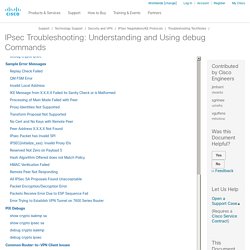
Software and PIX/ASA. This document assumes you have configured IPsec. Clear ip nat translation (static) Hi hope somenone can help me on this.
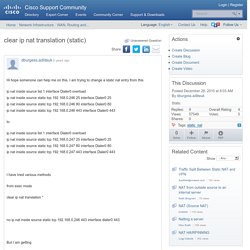
I am trying to change a static nat entry from this ip nat inside source list 1 interface Dialer0 overloadip nat inside source static tcp 192.168.0.246 25 interface Dialer0 25ip nat inside source static tcp 192.168.0.246 80 interface Dialer0 80ip nat inside source static tcp 192.168.0.246 443 interface Dialer0 443. NAT-NVI: translation failed (A) dropping packet. Utilizing the New Packet Capture Feature. When troubleshooting packet loss at a remote location where a sniffer trace isn't available, it's hard to isolate it to the LAN or WAN. In the new Cisco IOS 12.4(20)T there is a packet capture feature. The filters can be set based on interface name, direction, ACL, and even if it's to be punted to process level. The configuration command reference is available in the Troubleshooting and Fault Management page in the Packet Capture Infrastructure section. Update (April 8 2016): There is a tool available to Cisco Customer that simplifies the configuration, collection and extraction of the packet capture from the router.
How to Capture Packets on your Cisco Router with Embedded Packet Capture - Configuration, Troubleshooting & Data Export. If you’re tired of setting up SPAN sessions to capture network traffic transiting your network and Cisco router, it’s time to start using Cisco’s Embedded Packet Capture (EPC), available from IOS 12.4.20T and above. We will show you how to configure Cisco’s Embedded Packet Capture, to capture packets transiting a Cisco router, save them to its flash disk or export them directly to an ftp/tftp server for further analysis with the help of a packet analyzer such as Wireshark.
Finally, we've also included a number of useful Embedded Packet Capture troubleshooting commands to monitor the status of the capture points and memory buffer. Let’s take a look at some of the basic features offered by Embedded Packet Capture: Basic Cisco 800 Router Configuration for Internet Access. Advertisement The Cisco 800 series routers are part of the “Branch Office” category, used mainly for SOHO purposes or for connecting remote branch offices to a central location. They are “fixed hardware configuration” devices, meaning that they don’t have any plug-in hardware slots for inserting additional interfaces to the device (all the interfaces are fixed).
All the 800 series models come with a 4-port 10/100 managed switch used for connecting the internal LAN computers, and with an IOS software that supports security features including the Firewall set. The main difference of each model is the WAN interface. All models that end with “1” in the model number (i.e 851, 861, 871, 881, 891) have a 10/100 Fast Ethernet interface as a WAN port. Cisco et le routage inter VLAN. Nous allons dans ce billet mettre en place une architecture réseau basée sur des équipements Cisco (un routeur 1841 et un switch 2960).
Deux réseaux LAN différents (un pour les chefs, un autre pour le peuple) seront disponibles sur le même switch (en utilisant les fonctions VLAN). Le routage (et éventuellement le filtrage) entre ces deux réseaux LAN se fera par le routeur. Cisco 800 Series Integrated Services Routers Software Configuration Guide - Configuring a LAN with DHCP and VLANs [Cisco 800 Series Routers] Utilizing the New Packet Capture Feature. Setting Up A Cisco Router Firewall and DMZ. Our other Cisco router pages:Cisco VPN Routers with Windows PPTP ClientsAutomate the Monitoring of Cisco DevicesSetting up a DMZ with Cisco routers not only helps protect your internal network, but the PAT (Port Address Translation) feature in the Cisco IOS means you can send traffic destined for a single IP address to muliple servers. It does this by routing traffic to the appropriate server based on the destination port number. Traffic destined for is sent to your mail server, traffic destined for is sent to your Web server, etc.
IFM - How to configure a Cisco IOS router for IKEv2 and AnyConnect with Suite-B Cryptography. Perhaps your visiting this page because you want to use the latest (as of 2015) cryptography standards available - Suite-B. Perhaps you are interested in fully migrating to IKEv2. Or perhaps you are one of the many people using the "end of life" Cisco IPSec VPN Client, upgraded to Windows 10, and then found the support somewhat lacking.
Perhaps you have come across some articles on the Internet showing solutions, but you don't have Cisco ISE, a RADIUS server or a certificate server, so they wont work for you. Configuring Static NAT on Cisco Routers. In my previous post on NAT, I explained the difference between the 3 different types of NAT that can be configured. Cisco 867VAE en connexion VDSL2 avec Orange, enfin plus de LiveBox ! - Le blog d'Alexandre GIRAUD MVP Forefront. Ce n'est habituellement pas le genre d'articles que j'ai l'habitude de publier, mais là suite à un « ras-le bol » des LiveBox fournies par Orange j'ai fini par craquer en changeant de routeur. Alors le choix m'était quelque peu limité, car je suis actuellement sur les nouvelles lignes vDsl2 en Orange pro.
Les routeurs vDdsl2 ne courent pas les rues et ne sont pas aussi nombreux que les routeurs ADSL. J'ai donc opté pour un routeur Cisco 867 VAE K9, qui va donc me permettre d'avoir un contrôleur vDSL intégré, mais aussi l'iOS dans ce routeur sait faire des tunnels Ike v2 … Donc, oui vous l'avez compris je vais pouvoir ensuite faire une connexion avec la plateforme Microsoft Azure.